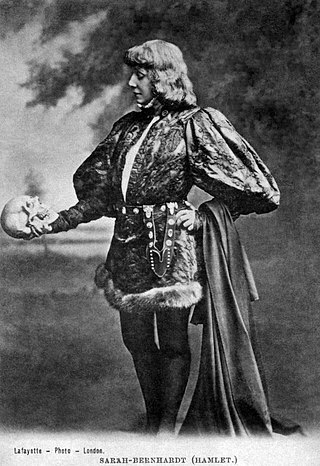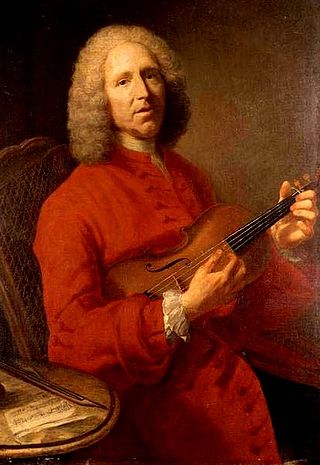A countertenor (also contra tenor) is a type of classical male singing voice whose vocal range is equivalent to that of the female contralto or mezzo-soprano voice types, generally extending from around G3 to D5 or E5, although a sopranist (a specific kind of countertenor) may match the soprano's range of around C4 to C6. Countertenors often have tenor or baritone chest voices, but sing in falsetto or head voice much more often than they do in their chest voice.

Travesti is a theatrical character in an opera, play, or ballet performed by a performer of the opposite sex.
The tenore contraltino is a specialized form of the tenor voice found in Italian opera around the beginning of the 19th century, mainly in the Rossini repertoire, which rapidly evolved into the modern "romantic" tenor. It is sometimes referred to as tenor altino in English books.

Jean-Paul Fouchécourt is a French tenor, mostly as an opera singer. He was born on 30 August 1958 at Blanzy in the Burgundy region. He is best known for singing French Baroque music, especially the parts called in French haute-contre, written for a very high tenor voice with no falsetto singing.

Hippolyte et Aricie was the first opera by Jean-Philippe Rameau. It was premiered to great controversy by the Académie Royale de Musique at its theatre in the Palais-Royal in Paris on October 1, 1733. The French libretto, by Abbé Simon-Joseph Pellegrin, is based on Racine's tragedy Phèdre. The opera takes the traditional form of a tragédie en musique with an allegorical prologue followed by five acts. Early audiences found little else conventional about the work.

Platée is an opera in a prologue and three acts by Jean-Philippe Rameau with a libretto by Adrien-Joseph Le Valois d'Orville. Rameau bought the rights to the libretto Platée ou Junon jalouse by Jacques Autreau (1657–1745) and had d'Orville modify it. The ultimate source of the story is a myth related by the Greek writer Pausanias in his Guide to Greece.

Isis is a French opera in a prologue and five acts with music by Jean-Baptiste Lully and a libretto by Philippe Quinault, based on Ovid's Metamorphoses. The fifth of Lully's collaborations with Quinault, it was first performed on 5 January 1677 before the royal court of Louis XIV at the Château de Saint-Germain-en-Laye and in August received a run of public performances at the Théâtre du Palais-Royal. It was Lully's first published score ; a full score was published in 1719.

Psyché is an opera in a prologue and five acts composed by Jean-Baptiste Lully to a libretto by Thomas Corneille. Based on the love story of Cupid and Psyche, Psyché was premiered on April 19, 1678 by the Académie Royale de Musique at the Théâtre du Palais-Royal in Paris.

French opera is both the art of opera in France and opera in the French language. It is one of Europe's most important operatic traditions, containing works by composers of the stature of Rameau, Berlioz, Gounod, Bizet, Massenet, Debussy, Ravel, Poulenc and Messiaen. Many foreign-born composers have played a part in the French tradition, including Lully, Gluck, Salieri, Cherubini, Spontini, Meyerbeer, Rossini, Donizetti, Verdi and Offenbach.

Le temple de la Gloire is an opéra-ballet by Jean-Philippe Rameau with a libretto by Voltaire. The work was first performed in a five-act version on 27 November 1745 at the Grande Écurie, Versailles to celebrate the French victory at the Battle of Fontenoy. It transferred, unsuccessfully, to the Paris Opéra on 7 December 1745. A revised version, in a prologue and three acts, appeared at the Opéra on 19 April 1746.

Les surprises de l'Amour is an opéra-ballet in two entrées and a prologue by the French composer Jean-Philippe Rameau. It was first performed in Versailles on 27 November 1748. The opera is set to a libretto by Gentil-Bernard. According to the usage of the time, it was originally just billed as a ballet and was only later classified by scholars as an opéra-ballet, although its content might more precisely ascribe it to the ballet héroïque genre.

Joseph Legros, often also spelt Le Gros, was a French singer and composer of the 18th century. He is best remembered for his association with the composer Christoph Willibald Gluck and is usually regarded as the most prominent haute-contre of his generation, though his acting is reputed to have been mediocre.

Pierre Jélyotte was a French operatic tenor, particularly associated with works by Rameau, Lully, Campra, Mondonville and Destouches.
Dumesnil was a French operatic tenor. His surname is sometimes found spelt Duménil, Dumény, du Mény, or Du Mesny.
Baritenor is a portmanteau (blend) of the words "baritone" and "tenor". It is used to describe both baritone and tenor voices. In Webster's Third New International Dictionary it is defined as "a baritone singing voice with virtually a tenor range". However, the term was defined in several late 19th century and early 20th century music dictionaries, such as The American History and Encyclopedia of Music, as "a low tenor voice, almost baritone [sic]."

Baroque music refers to the period or dominant style of Western classical music composed from about 1600 to 1750. The Baroque style followed the Renaissance period, and was followed in turn by the Classical period after a short transition. The Baroque period is divided into three major phases: early, middle, and late. Overlapping in time, they are conventionally dated from 1580 to 1650, from 1630 to 1700, and from 1680 to 1750. Baroque music forms a major portion of the "classical music" canon, and is widely studied, performed, and listened to. The term "baroque" comes from the Portuguese word barroco, meaning "misshapen pearl". The works of George Frideric Handel and Johann Sebastian Bach are considered the pinnacle of the Baroque period. Other key composers of the Baroque era include Claudio Monteverdi, Domenico Scarlatti, Alessandro Scarlatti, Alessandro Stradella, Tomaso Albinoni, Johann Pachelbel, Henry Purcell, Antonio Vivaldi, Georg Philipp Telemann, Jean-Baptiste Lully, Jean-Philippe Rameau, Marc-Antoine Charpentier, Arcangelo Corelli, François Couperin, Johann Hermann Schein, Heinrich Schütz, Samuel Scheidt, Dieterich Buxtehude, Gaspar Sanz, José de Nebra, Antonio Soler, Carlos Seixas and others.
Comédie-ballet is a genre of French drama which mixes a spoken play with interludes containing music and dance.
The grand motet was a genre of motet cultivated at the height of the French baroque, although the term dates from later French usage. At the time, due to the stylistic feature of employing two alternating choirs, the works were typically described as motet pour deux choeurs - motet for double choir.
Joseph Michel (1679–1736) was an 18th-century French baroque chorister, composer and music teacher of the Sainte Chapelle of Dijon, demolished in 1802. A contemporary of Jean-Philippe Rameau, his reputation extended far beyond the boundaries of the city of Versailles and Burgundy.









